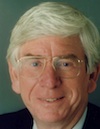Dr. Lev Zetlin was a Russian-born, charismatic, creative structural engineer who surrounded himself in his New York City practice with very bright, young, well-educated engineers. Once he liked you, the first thing he would do was give you a copy of Machiavelli's "The Prince" to read and discuss with him. In 1962,Zetlin's start-up company landed 14 contracts for the 1964 New York World's Fair, an unbelievable accomplishment for a firm of 10 people.
I benefited greatly from joining Lev Zetlin Associates (LZA) as work started on the World's Fair projects. During those years, I also worked on my master's degree, and had access to New York University's computer complex. No one else at LZA knew about computers, but I knew about finite element modeling and I was given all the special assignments that involved theoretical and analytical skills. This experience enabled me to rise quickly through the ranks at the company.
In the early days of LZA, every Friday at about two o'clock, Zetlin would call us into his office to tell us that we had to work on the weekend to complete a project by Monday morning. We called it the "Friday afternoon crisis." We all got used to it. At least we were paid overtime and made more money, which helped a starving graduate student.
One of LZA's approaches to management involved pushing young employees into the deep end of the pool, encouraging them to take initiative and work within controlled risks. Most of the key staff when I joined were in their early to mid-20s and were from Manhattan College. Vincent DeSimone was essentially running the office by 1964, and the best structural engineer was James Chaplin. Chaplin was older and had an uncanny ability to cut back a structure in the pre-computer days. We ended up designing the World's Fair pavilions, at least five of which had structural systems that had never been done before.

THORNTON
I had one additional challenge: During the second of two separate stints with LZA, I worked on a series of hangars in Los Angeles and San Francisco for American Airlines' new Boeing 747 aircraft. We needed a person to sign and seal the structural drawings-Zetlin himself was not licensed in California, which requires a special exam. When asked how this would be solved, Zetlin told American Airlines not to worry: I was going out to take the test in two weeks. Talk about pressure.
As for strategy, our team would always propose three schemes for every project: the wild and crazy, the small step forward for mankind and the plain vanilla. Rarely did the wild-and-crazy scheme get selected, but that was the one the architects always loved and the one that left a lasting impression that we were a very creative team. We usually ended up doing something between the wild-and-crazy and the small-step-forward schemes.
I was still naive about many things and hadn't travelled much. When architect Jim Rossant and I flew to Los Angeles to look at the airlines' existing hangars, we arrived at 11 a.m., but all the aircraft were flying. Having nothing to do for a while, Jim and I took a bus 17 miles to the Santa Monica cliffs, walked down the stairway, rolled up our pants legs and waded into the cold water of the Pacific.
The hangar project was probably one of the most creative periods of my structural-engineering life. Once design work started in earnest, to achieve obstruction-free spaces large enough for four 747 jets, we designed enormous bay hangars. They had huge cantilevers using light-gauge metal deck webs in hyperbolic paraboloid (hypar) configurations, a practical application of Zetlin's research in the early 1960s. The two hangars are still in use today. I was 28 years old when we started the design work and 32 years old when we finished it. Much later in my career, after Richard Tomasetti and I had bought the company, I would design what, at the time, was the world's tallest building. But in my mind, the hangar project was the most elegant n
Charles H. Thornton, a founder of Thornton Tomasetti PC, designed some of the tallest buildings in the world. This excerpt is from his memoir, "Charles Thornton: A Life of Elegant Solutions," the proceeds from which will support the ACE Mentor Foundation, which Thornton founded in 1995.
To order the book, go to alifeofelegantsolutions.com or call 410-924-4292.

Post a comment to this article
Report Abusive Comment